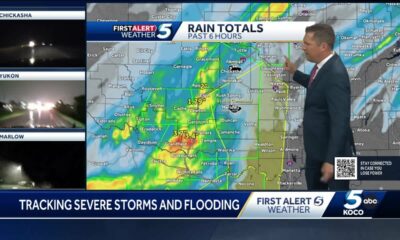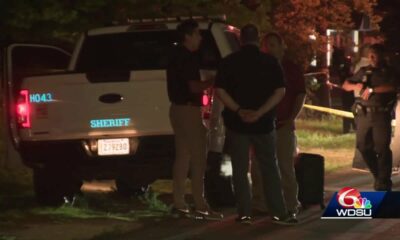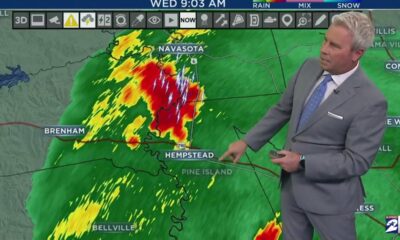News from the South - Arkansas News Feed
Arkansas town hit hard by tornado making progress
by Ainsley Platt, Arkansas Advocate
March 31, 2025
Cave City was quiet last week.
The day after a high-end EF-3 tornado ripped through the small Sharp County town with 165-mile-per-hour winds on March 14, the main stretch had been abuzz with volunteers, heavy machinery and people sifting through what remained of their homes, businesses and storage units.
Fifteen tornadoes touched down in Arkansas during the March 14-15 severe weather event, according to the National Weather Service. Three people were killed in neighboring Independence County by the same tornado that devastated Cave City. That tornado was also the longest-tracked tornado in Arkansas since 2008, according to the weather service, remaining on the ground for over 80 miles — something the service noted as being “exceptionally rare” for a tornado in Arkansas.
Fast forward a week and a half, and the atmosphere in town has changed. Power lines no longer litter the sidewalk on one side of Main Street. People weren’t slowing in their cars, gawking and taking videos on their phones as they drove past the destruction. Cell service had been restored, even if it was somewhat spotty.
The cleanup had made remarkable progress, even after a week that began with a tornado and continued with whipping winds and fires that burned homes in an already-devastated area.
The remains of the town’s pharmacy — totalled by the tornado — are gone. Only a concrete pad and a small pile of rubble remain. The church and the grocery store are surrounded by fences, their roofs covered with tarps and sheet metal to keep out future rain. An excavator began tearing into a brick house next door to the grocery store, pulling down what remained of its roof.
Other than people operating heavy machinery — clearing debris and trees — not many people were walking around.
Irma Carrigan, who runs the Crystal River Cave Tours and Motel, said the day after the storm that she wasn’t convinced the hordes of volunteers and support that arrived in town after the storm would last. But on Wednesday, a week and a half after the tornado that totaled her car and pulled down a massive tree in her yard, crushing one of the many small buildings on her property, Carrigan said she’d been pleasantly surprised by just how much people wanted to help, noting that she hadn’t heard one complaint from those who had arrived to offer assistance.
“It has all been very positive, very caring people,” Carrington said. “They set up food centers for different places. We didn’t have to cook during all of that.”
“The volunteerism is just phenomenal,” Carrington said. Still, sometimes it could be overwhelming, she noted, being asked by volunteers how to help when those impacted themselves still weren’t sure.
“You just look ignorant to them because you’re just saying, ‘I don’t know,’” Carrington said.
The waves of volunteers ebbed about five days after the storm, Carrigan reported, but she was grateful for the help she got. A nonprofit brought in a crane, cut up the huge tree into chunks, and helped haul it onto a family friend’s truck. Some roofers reattached a part from her roof that had blown off in the storm.
Still, other things have been slow coming. Carrigan said that as of Wednesday, they were still being told they had to boil their water. Their internet only returned two days prior, and cell service wasn’t always reliable.
In the aftermath of the storm, sleep was sometimes hard to come by.
“Your brain won’t turn off,” Carrigan said. “I think mentally, you can’t shut it off. You’re still thinking, ‘What am I going to be doing tomorrow? What can I do?’ You just continue to pray that you’ll get guidance and where you need to go next.”
Walking down one of the roads that branched off from Main Street, Carrigan pointed to her neighbors’ houses. The white, two-story, former boarding house next to hers was the oldest in town, she said, and one of its occupants was on hospice. It was badly damaged.
Next door to it was a smaller house, the back of it torn open. Those neighbors, Carrigan said, were trapped under the rubble of their home for hours after the tornado hit. One of them was over 90 years old. She said she’d heard that the property had already been sold to someone else.
The yellow house even farther down was occupied by another elderly neighbor in their 90s, Carrigan reported. They planned to repair the damage, she’d heard.
Another neighbor will tear down and put in a mobile home, Carrigan said. Yet another told Carrigan they were considering a modular home.
“He said, ‘I’m too old to build. I’m too old to rebuild,’” Carrigan said of the neighbor who was considering a mobile home. “And he said, ‘I want something; I don’t want to wait two or three years to get it.’”
Some people were scared to even clean their windows until their insurance appraisers showed up, Carrigan said, leaving some in a state of limbo.
Carrigan expressed support for a federal disaster declaration, which Gov. Sarah Huckabee Sanders requested last week. Sander asked for additional federal help over the weekend.
“I would think they would,” Carrigan said of the federal government helping with disaster recovery. “I mean, I can’t imagine a disaster any worse.”
However, the Federal Emergency Management Agency, which normally manages federal disaster responses, is in the crosshairs of the Trump administration as one of its targets to be shut down, with the Washington Post reporting that Department of Homeland Security Secretary Kristi Noem expressed support for removing FEMA’s role in recovering from disasters by October.
It’s unclear how such an action would impact a federal disaster response in Arkansas if the declaration is approved. Stateline reported last month that disaster experts and states have said that they aren’t able to take on the role FEMA currently fills.
Carrigan wasn’t the only one who would like to see the disaster declaration approved. Brandi Schulz, the executive director of the Cave City Area Chamber of Commerce, said the money that would be available to both businesses and residents would help with the recovery.
“From a chamber director perspective, I know that (a federal disaster declaration) would open up some options for our businesses that were impacted,” Schulz said. “I know that there were going to be more options, supplemental options, outside of insurance if that does go through, so in that regard, I am hoping that we can get more assistance to our businesses and also to our residents.”
Schulz described Cave City as a “very DIY community,” and said that it, combined with the support of volunteers and donors, meant that the city would likely be in “a very good place” on debris removal within the next week. Roughly 59 people have been displaced by the tornado in the area, Schulz estimated.
Taking care of the physical needs of those who were affected doesn’t just mean helping clear debris, however. Schulz said the wife of the town’s fire chief, whom the chamber director said “specializes in trauma debriefing,” has been offering resources for the community.
“I think the biggest thing is people knowing that they’re not alone, that we’re here for them,” Schulz said. “And I think we’ve shown that in the last week or so.”
Carrigan expressed some frustration with communication from state and local authorities, even as she said she appreciated what they were doing and was satisfied with the rate at which cleanup and recovery had been happening. She heard that state money was available to those impacted to help with storm recovery, but wasn’t able to figure out how to apply. She said the Red Cross opened a shelter, only to close it 48 hours later.
“I went up to the Assembly of God to check out, try to find this Red Cross and they said, ‘Well, they were here, but nobody came up here to use their services,’” Carrigan said. “And I said, ‘Well, honey, nobody knew that they were here.’”
Schulz said local officials made efforts to reach people who weren’t able to get online information, at one point distributing fliers, she said.
The Red Cross confirmed it closed the shelter due to lack of use.
“We had some families that expressed interest, and then had found other places to say,” Red Cross regional spokesperson Sharon Watson said, adding that they had been coordinating with local faith leaders and town officials to get the word out. “Some had requested hotels, and we didn’t have hotel vouchers to offer because we had a shelter set up, and our shelter was available so therefore they opted to find other places to stay, which we completely understand.”
Watson noted that the shelter wasn’t the only way it was helping the community. On Thursday, the Red Cross opened several “Multi-Agency Resource Centers” in conjunction with the Arkansas Voluntary Organizations Active in Disaster for those affected by the tornado outbreak, designed to serve as a “one-stop shop” for residents to get answers from state and local authorities about disaster assistance.
The MARCs were open from Thursday to Sunday in different cities — Diaz on Thursday, Cave City on Friday, Melbourne on Saturday, and Pocahontas on Sunday.
Meanwhile, management of volunteers and donations was handed over to Eight Days of Hope, a Christian nonprofit, after being managed by local officials such as Schulz.
Gale Manning, the rapid response manager for the Cave City relief efforts, said the organization will be on the ground until April 5. Volunteers have been helping cut up and haul off trees, he said, to help make the area safer. He said roughly 70 to 80 people had been volunteering on the weekdays, with volunteers coming from as far away as Alaska.
“They’re devastated,” Manning said of the people who had been impacted by the storm. “They’ve lost their life savings, belongings. But, you know, as the days go on, they feel a bit better. Again, we share the gospel and we let them know that God’s in control and that he knows what’s going on, and he promised us all a better day.”
Arkansas Advocate is part of States Newsroom, a nonprofit news network supported by grants and a coalition of donors as a 501c(3) public charity. Arkansas Advocate maintains editorial independence. Contact Editor Sonny Albarado for questions: info@arkansasadvocate.com.
The post Arkansas town hit hard by tornado making progress appeared first on arkansasadvocate.com
News from the South - Arkansas News Feed
Arkansas Army vet uses experience to help other veterans
SUMMARY: Arkansas Army veteran Jared Eeken uses his military experience and counseling background to help struggling veterans through his nonprofit, Scars and Stripes. Recognizing gaps in existing support systems, Eeken assists veterans in navigating mental health challenges, finding jobs, healthcare, and transportation, ensuring they don’t fall through the cracks. His own struggles with mental health inspired him to create this organization alongside his wife. Eeken emphasizes the importance of camaraderie and continuous support, often advocating for veterans to receive the services they’re entitled to. Recently, he was honored with the Saluting Heroes Award for his impactful work aiding Arkansas veterans.

One Arkansas Army veteran is showcasing how he uses his knowledge of social work and his own experiences to help other veterans in the state.
News from the South - Arkansas News Feed
Latest updates on Conway park shooting
SUMMARY: Two suspects remain on the run after the Conway Park shooting, while two others are in custody. One of the arrested suspects, Ryan Goens, was free on bond for a previous gun charge at the time of the shooting. He had posted a $75,000 bond for an alleged February gun crime, including possession of a machine gun, and was scheduled for a hearing the same week as the shooting, but it was postponed. This case has raised concerns about the state’s bail system and balancing public safety with the presumption of innocence. Goens faces 11 counts of aggravated assault.

As the search continues for two additional suspects in the Conway park shooting, here’s the latest information from police.
News from the South - Arkansas News Feed
Report: Arkansas pre-K landscape meets most quality standards, still has room for improvement
by Tess Vrbin, Arkansas Advocate
April 29, 2025
Arkansas preschool programs met eight of 10 benchmarks in a national early childhood education group’s analysis of the state’s pre-K efforts.
Some of the standards Arkansas meets are class sizes of 20 children or fewer, at least one teacher per every 10 students, specialized pre-K training for teachers and “comprehensive, aligned, supportive, culturally sensitive” early learning and development standards, according to the National Institute for Early Education Research (NIERR), housed at Rutgers University.
Arkansas falls short in its early childhood education degree requirements and annual staff professional development, the report noted. Arkansas does not require all early childhood educators to hold bachelor’s degrees, and the state requires a minimum of 15 hours of professional development per year while the report says at least 30 should be required.
Arkansas ranked 31st nationwide in state spending on early childhood education during the 2023-24 school year, and its spending per student decreased while its enrollment of 3- and 4-year-olds in pre-K remained steady, according to NIERR’s nationwide analysis of state preschool programs released Tuesday.
The state’s preschool program, Arkansas Better Chance (ABC), serves children ages 3 and 4 from families earning up to 200% of the federal poverty level. ABC enrolled 20,311 children during the last school year, accounting for 19% of 3-year-olds and 32% of 4-year-olds statewide, according to the NIERR report.
While ABC enrollment increased by 1,063 children compared to the previous school year, overall spending decreased by more than $43 million, and spending per student decreased by $2,564, with those figures adjusted for inflation, the report states.
Federal funds helped Arkansas childcare providers stay afloat, but staffing struggles continue
Arkansas spends $2,016 less per student and nearly $41 million less overall than what the report considers “adequate” for its early childhood education landscape. The report defines adequacy as enough money to “support minimum quality standards and provide K-12 pay parity for preschool teachers within their current operating structures.”
The starting annual salary for Arkansas’ K-12 teachers increased from $36,000 to $50,000 in 2023 due to the wide-ranging LEARNS Act. This pay disparity between educators who teach 5-year-olds as opposed to 4-year-olds makes it challenging to maintain a robust pre-K workforce, early childhood education administrators told the Advocate in November 2023.
Arkansas has not implemented any “statewide initiatives or minimum set pay” to bolster the early childhood education workforce, which not only affects the overall quality of the system but also forces some preschool educators to rely on public assistance to meet their needs, Nicole Carey, policy director for Arkansas Advocates for Children and Families, said in an interview Monday.
State spending per child enrolled in pre-K was at its lowest in nearly two decades during the 2023-24 school year, according to the NIERR report. Spending spiked during the COVID-19 pandemic but has since dropped, and it saw little change and no upward trend during most of the 2010s. Meanwhile, Arkansas’ rates of child enrollment in pre-K have returned to their pre-pandemic levels after decreasing in the early 2020s, according to the data.
“It would be great if we could have additional state investment in the ABC program, either toward educator wages or other types of workforce support,” Carey said.
Arkansas Democratic lawmakers introduced a bill this year that would have created a tax credit for early childhood educators, and a Republican-sponsored bill would have created a similar policy for “a licensed childcare provider.” Neither bill advanced.
GET THE MORNING HEADLINES.
Eleven states met nine or 10 of the NIERR standards, and none of those 11 states were “low spenders” because “money does matter for quality,” Steve Barnett, NIERR’s senior director and a co-author of the report, said in a virtual press briefing Friday.
Overall, Arkansas ranked 8th nationwide in 3-year-olds enrolled in pre-K, while 15 states do not have pre-K programs for 3-year-olds at all, according to the report. Arkansas ranked 24th in enrollment of 4-year-olds.
Additionally, 5% of 4-year-olds and 7% of 3-year-olds in Arkansas were enrolled in the federally-funded Head Start program in 2023-24, while 15% of 4-year-olds and 4% of 3-year-olds were enrolled in special education, the report states.
Arkansas has 28 Head Start locations statewide. Federal employees who administer Head Start have faced recent layoffs, but changes on the federal level have not impacted the program in Arkansas, said Leslie Taylor, spokesperson for Head Start’s Arkansas grantee, the University of Arkansas for Medical Sciences.
The state Department of Education oversees the Office of Early Childhood, which was under the jurisdiction of the Department of Human Services before the LEARNS Act went into effect in 2023. The law also required “local lead” organizations throughout the state to assess local and regional access to pre-K and what gaps or barriers should be addressed.
Need to get in touch?
Have a news tip?
Most of the local lead organizations are education cooperatives, along with some school districts and child care organizations, according to the Department of Education.
AACF is “hopeful” that local leads will create “positive growth” in their areas, Carey said.
“For the local leads that I’ve spoken with, they have put in a lot of work and are doing a good job trying to connect with their communities,” she said.
Arkansas Advocate is part of States Newsroom, a nonprofit news network supported by grants and a coalition of donors as a 501c(3) public charity. Arkansas Advocate maintains editorial independence. Contact Editor Sonny Albarado for questions: info@arkansasadvocate.com.
The post Report: Arkansas pre-K landscape meets most quality standards, still has room for improvement appeared first on arkansasadvocate.com
Note: The following A.I. based commentary is not part of the original article, reproduced above, but is offered in the hopes that it will promote greater media literacy and critical thinking, by making any potential bias more visible to the reader –Staff Editor.
Political Bias Rating: Center-Left
This article presents a detailed analysis of Arkansas’ early childhood education programs, focusing on the state’s funding, standards, and legislative efforts. It highlights shortcomings in funding and support for pre-K educators and advocates for increased investment and professional development. The inclusion of perspectives from education advocates and Democratic lawmakers, and emphasis on the need for state intervention and funding parity, align with center-left priorities on education equity and public investment. The article is factual and balanced but leans toward supporting stronger government involvement in education funding and workforce support.
-

 News from the South - Missouri News Feed4 days ago
News from the South - Missouri News Feed4 days agoMissouri lawmakers on the cusp of legalizing housing discrimination
-

 Mississippi Today3 days ago
Mississippi Today3 days agoDerrick Simmons: Monday’s Confederate Memorial Day recognition is awful for Mississippians
-

 Mississippi Today6 days ago
Mississippi Today6 days agoStruggling water, sewer systems impose ‘astronomic’ rate hikes
-

 Mississippi Today1 day ago
Mississippi Today1 day agoTrump appoints former Gov. Phil Bryant to FEMA Review Council as state awaits ruling on tornadoes
-

 News from the South - West Virginia News Feed6 days ago
News from the South - West Virginia News Feed6 days agoIs West Virginia — and the rest of the country — prepared to care for our seniors?
-

 News from the South - Florida News Feed5 days ago
News from the South - Florida News Feed5 days agoFlorida woman accused of setting fires during burn ban
-

 News from the South - Louisiana News Feed6 days ago
News from the South - Louisiana News Feed6 days agoTaxes on vapes and smokeless tobacco advance through committee | Louisiana
-

 News from the South - Texas News Feed7 days ago
News from the South - Texas News Feed7 days agoStorms Move Through Houston: Expect Heavy Rain and Possible Flooding This Afternoon





































